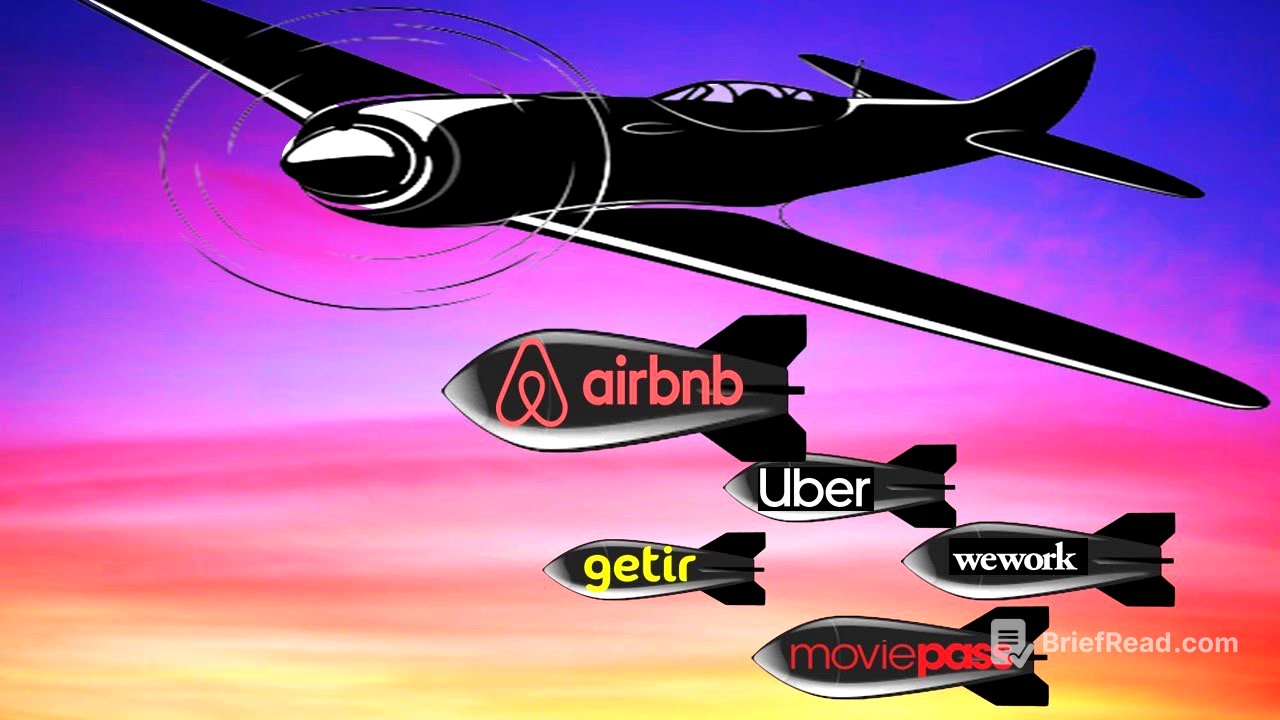TLDR;
This video discusses the "blitzscaling" business model, popularized by Silicon Valley, where companies prioritize rapid growth over immediate profitability, often relying on venture capital to subsidize services and undercut competitors. It explores the potential benefits and drawbacks of this approach, using examples like Uber, Amazon, and MoviePass to illustrate its successes and failures. The video also touches on the social costs of blitzscaling and its potential implications for consumers and the broader economy.
- Blitzscaling prioritizes rapid growth over immediate profit, aiming for market dominance.
- Network effects and low interest rates can justify large initial losses.
- Examples include Uber, Amazon, and MoviePass, with varying degrees of success.
- The model can lead to consumer benefits but also has social costs and potential for market distortion.
- The future of blitzscaling depends on economic cycles and investor willingness to fund losses.
Introduction to Blitzscaling [0:00]
The video begins by highlighting how the time it takes for companies to reach a $1 billion market cap has decreased significantly. Traditional companies took around 20 years, while tech companies like Google, Facebook, and Uber achieved this milestone in a fraction of the time. There are two main approaches to growing a company: the traditional method of focusing on profitability from the start and the blitzscaling method of prioritizing rapid growth and market dominance, even if it means incurring significant losses initially.
The Blitzscaling Model Explained [0:21]
Blitzscaling is a strategy primarily used in network-effects businesses, where the value of a product or service increases with the number of users. The goal is to become the dominant player in the industry and then pivot to profitability. This approach involves aggressive user acquisition, often through subsidized services, with the expectation that user acquisition costs will decrease as the company scales. The strategy is particularly appealing when interest rates are low, as future profits are discounted at a lower rate, making long-term growth investments more attractive.
Examples of Blitzscaling Companies [2:42]
Several companies, such as Deliveroo, Getir, and Gopuff, exemplify the blitzscaling model. These companies often operate with negative cash flow and an uncertain path to profitability but have achieved high valuations due to their rapid growth. Other examples include companies that flooded cities with rental bicycles and electric scooters. Airbnb and Uber are also cited as examples of companies that used blitzscaling to achieve market dominance, with Airbnb leveraging its ability to spend more on growth and Uber using aggressive tactics to bypass regulations and gain users quickly.
Blitzscaling as a Military Tactic [3:29]
Reid Hoffman, who coined the term "blitzscaling," drew inspiration from the World War II German military tactic "blitzkrieg." The idea is to move very fast by carrying only essential resources, surprising the competition, and achieving a quick victory. This approach involves taking on more risk than traditional scaling methods, which can be necessary for both offensive and defensive reasons. Offensively, a certain scale may be required for a business to be valuable, as seen with LinkedIn, eBay, PayPal, and Amazon. Defensively, scaling faster than competitors can secure customers and create a winner-takes-most scenario.
The Softbank Vision Fund and Blitzscaling [6:14]
The Softbank Vision Fund, founded in 2017 with over $100 billion in capital, is a prime example of a fund that supports blitzscaling. The fund invests heavily in one startup within a competitive sector, providing it with the resources to outspend competitors on customer acquisition, marketing, and price cuts. This strategy aims to eliminate competition and dominate the market, with the expectation that profitability will follow in the long term.
Uber's Blitzscaling Strategy and Current Challenges [8:29]
Uber's "move fast and break things" approach allowed it to quickly establish itself in new cities, often bypassing regulations. The company's referral program, which offered ride credits for signing up friends, facilitated rapid growth. While Uber should theoretically be a low-cost platform, it has faced challenges in achieving profitability due to intense competition and the need to balance prices and driver compensation. The company has recently shifted its focus towards profitability, reducing experimental projects and headcount.
The Spread of Blitzscaling Beyond Silicon Valley [10:19]
The blitzscaling model has expanded beyond Silicon Valley, with companies like Spotify and numerous delivery, shopping, and rental services adopting the strategy. Amazon is considered the "king of the blitzscalers," having grown rapidly and diversified its services while initially prioritizing growth over profits. However, not all companies have replicated Amazon's success, as seen with the numerous "Uber for X" startups that failed to achieve sustainable growth.
MoviePass: A Cautionary Tale [11:49]
MoviePass serves as an example of a failed blitzscaling venture. The subscription-based movie ticketing service allowed members to watch unlimited movies for a low monthly fee, resulting in losses for the company with each customer visit. The company's business model was unsustainable, and it ultimately went bankrupt. MoviePass illustrates the risks of blitzscaling when the core economics of the business are flawed.
The Limitations and Social Costs of Blitzscaling [13:08]
Blitzscaling is more suitable for software-based businesses with low marginal costs than for businesses requiring significant physical assets and employees. Companies like WeWork, which leased and re-rented office spaces, faced different economic challenges. The blitzscaling model also has social costs, including the destruction of competing businesses and negative impacts on workers. For example, the value of New York City taxi medallions plummeted due to competition from Uber, and mom-and-pop bookstores have largely disappeared due to Amazon.
The Future of Blitzscaling and its Economic Implications [16:31]
An economy dominated by unprofitable companies can distort economic growth and lead to market concentration. While consumers may benefit from subsidized goods and services in the short term, they may later face price hikes and reduced benefits. The video questions whether blitzscaling is countercyclical, with companies raising prices during economic downturns when customers are struggling. The long-term success of blitzscaling remains uncertain, and it may ultimately be viewed as a flawed model, similar to the dot-com bubble. The video concludes by suggesting that universal basic income could be a logical extension of blitzscaling, as it would ensure rapid user adoption and eliminate the complexities of other subsidized services.









